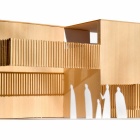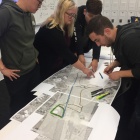For decades, the area around Northland Avenue suffered from divestment and abandonment, especially as many of its former manufacturing anchors succumbed to outside economic forces. Due to the adjacent Belt Line railroad, the corridor had become a strategic industrial hub able to move both people and products en masse. Once home to manufacturers such as Houdaille Industries, Otis Elevator Company, Curtiss-Wright Corporation, Northland Rubber Company, and Niagara Machine & Tool Works (later Clearing Niagara), the products that left the loading docks went on to forge modern America. A blue-collar workforce, building aircraft engines, plunger elevators, and automobile parts, established residency near their employers starting around the turn of the 20th Century. Over time, this pattern of settlement formed the Delavan Grider neighborhood we know today.






















